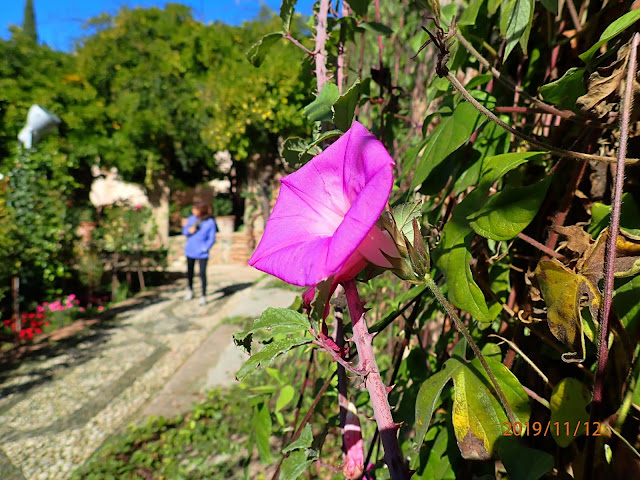 |
| The terracing terrain of Alcala la Real from the castle down to the small town of a population of about 21,000 people. A place that could be considered to stay for retirement. |
 |
| Casa Grande is one of the many old buildings built hundred of years ago with a sub level where our Bromptons were kept. |
 |
| A short distance to the bus terminal from Casa Grande and we were waiting for the bus. |
 |
| Some of the places that are connected to Alcala la Real by bus as seen on the wall. Another time for a re visit Spain with all these places to explore. |
 |
| I got a fantastic view sitting next to the driver. |
 |
| As we were approaching Granada, I saw a similar practice back home where a man was peddling to sell stuff at a traffic light juncture. It's really tough making a living in almost everywhere. Be blessed in what ever we have and let's live simple. |
 |
| Why I was sitting at the assistant driver's seat, the bus company over sold its tickets. A few were asked to take the next bus and I was offered the front seat instead of sitting at the aisle. |
 |
| There was a stop before the final halt at the terminal, nearly half the load ended their journey here. I had to get down the bus to make way for the passengers to disembark. |

All I know about Granada is something to do with a Korean movie and the word Alhambra continuously ringing to me. I shall find out more in the next few days in Granada. Let's set up our bicycles and see Granada. Location of the bus terminal is at GPS :
37.199836, -3.613198
 |
| The main entrance of the Bus Terminal of Granada and yes we have arrived at one of the famous tourist spots of Spain, Granada. Most visited place by tourists from all the world and we were here to add on the statistic. |
 |
| The long time capital of Moorish Andalusia is awaiting us to explore and at the same time we shall get to know a bit of its history. |
 |
| The distance from the bus terminal to our next accommodation was about 5km away. |
 |
| The apartment for the next three nights in Granada called as Campo Del Principe (meaning the Prince's Field) located at Calle Escutia GPS : 37.172384, -3.592590 |
 |
| It's nice to see one of the two bags couriered from Porto has arrived at the apartment. The other bag was couriered to Barcelona. The bags for our bicycles when they need our folded bikes to be bagged and flown in a plane. |
 |
| Time for a lunch at Papaupa Retrofusion Food at Calle Molinos, GPS : 37.173242, -3.593106 |
 |
| The food was good so was the strength of the wifi. |
 |
| I was beginning to get the hang of eating the olive taste. Taking the irresistible preserved seed at almost all our meals. This one came together with a tapas. |
 |
| A beer with no stick on label. Alhambra was founded, as you can imagine, in the Andalusian city of Granada in 1925. Today it is the signature brand of this city, and one of the most widely consumed beers in southern Spain. Easy to drink, this is an outstanding example of a European lager. Golden amber in color, with a full bodied flavor developed over a slow, controlled fermentation of roughly 60 days. Mild grassy hop aromas along with hints of grain malt. Medium-light bodied and lightly carbonated. Perfectly balanced, with notes ranging from bitter orange to a slightly caramel finish. |
 |
| After the lunch we took out our bicycles and went roaming around the neighbourhood. Coming down the steep road from Alhambra Palace Hotel along Cuesta del Caldera street we stopped at a wall mural for photography. Location GPS : 37.170374, -3.588664 |
 |
| A popular fountain of the Granadas with a bronze sculpture by Grenadian Ramiro Megías. Where is the water? GPS : 37.169352, -3.595767 |
 |
| The Genil River flowing through the city at a green park in an elongated shape. Wonder why it so dry in Granada? |
 |
| Taking a welfie with a mascot from a pastry joint (I am just guessing) he was fun and friendly. |
Another iconic fountain at the Plaza del Campillo was dry too and it is known as Fuente de las Batallas. Situated at Calle Acera del Casino, GPS : 37.172118, -3.598660
 |
| Next to the fountain is this attractive sculpture and one for the album. |
 |
| Fenn sent her bike to check on her break at Bicicletas La Estación, Brompton bikes are sold here and for the first time I saw a e-Brompton. They did not charge Fenn for the checking. Thank you for much. |
 |
Abutting each other is Iglesia del Sagrario, a Catholic church and the Royal Chapel of Granada on the right. Behind them is the huge Cathedral of Granada. Location GPS : 37.176047, -3.598568. I enjoyed the songs and music sung by the busker while some went in the church.
|
 |
| That was the last place we visited for the day and left the historical place at this lane named as Calle Oficios. |





























































